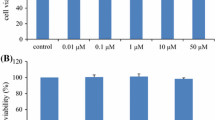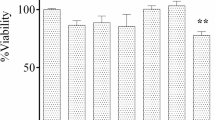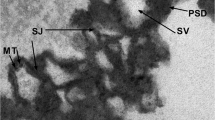Abstract
Aggregation of Aβ is a pathological hallmark of Alzheimer’s disease (AD). The purpose of this study was to identify the protective roles of different polysaccharide components in Fomes officinalis Ames polysaccharides (FOAPs) against Aβ25–35-induced neurotoxicity in PC12 cells. Different doses of FOAPs components (i.e. FOAPs-a and FOAPs-b) were added to PC12 cells about 2 h before β-amyloid protein fragment 25–35 (Aβ25–35) exposure. The AD cellular model of PC12 cells was established using Aβ25–35. Then the PC12 cells were divided into 9 groups including: control group, Donepezil hydrochloride (DHCL) group, model group treated using 40 μM Aβ25–35, followed by FOAPs-a and FOAPs-b interference (50, 100 and 200 μg/mL). The mitochondrial reactive oxygen species (ROS), ATP, superoxide dismutase (SOD), malondialdehyde (MDA), lactate dehydrogenase (LDH) and mitochondrial membrane potential (MMP) were determined by commercial kits. The Cytochrome C, Bcl-2 and Bax expressions in the mitochondria and cytosol was determined by using Western blot analysis. FOAPs-a and FOAPs-b could significantly inhibit the LDH release, MDA level and the over accumulation of ROS induced by Aβ25–35 in PC12 cells in a dose-dependent manner. They could also effectively prevent Aβ25–35-stimulated cytotoxicity, which involved in attenuating cell apoptosis, increasing the ratio of Bcl-2/Bax and inhibiting Cytochrome C release from mitochondria to cytosol in PC12 cells. Moreover, FOAPs-a and FOAPs-b significantly alleviated mitochondrial dysfunction by regulating the MMP, as well as promoting the mitochondrial ATP synthesis. FOAPs-a and FOAPs-b played neuroprotective roles against Aβ25–35-induced cytotoxicity in PC12 cells through suppressing the mitochondria-mediated apoptotic pathway.




Similar content being viewed by others
Abbreviations
- Aβ:
-
Amyloid-β protein
- AD:
-
Alzheimer’s disease
- FOAPs:
-
Fomes officinalis Ames polysaccharides
- MMP:
-
Mitochondrial membrane potential
- β-APP:
-
Beta amyloid precursor protein
- Aβ25–35 :
-
β-amyloid protein fragment 25–35
- DHCL:
-
Donepezil hydrochloride
- Nrf2:
-
Nuclear related factor 2
References
Abuliz P, Tuoheniyazi R (2013) Study on the anti-aging effect of Fomes officinalis Ames Ames polysaccharides. China J Tradit Chin Med Pharm 28:340–342
Ainiwaer Y, Abulizi P (2016) Isolation, purification and basic composition analysis of polysaccharides from Fomes officinalis Ames. J Food Saf Qual 7:3992–4000
Albensi BC (2019) Dysfunction of mitochondria: implications for Alzheimer’s disease. Int Rev Neurobiol 145:13–27. https://doi.org/10.1016/bs.irn.2019.03.001
Briston T, Hicks AR (2018) Mitochondrial dysfunction and neurodegenerative proteinopathies: mechanisms and prospects for therapeutic intervention. Biochem Soc Trans 46:829–842. https://doi.org/10.1042/bst20180025
Chen GF, Xu TH, Yan Y, Zhou YR, Jiang Y, Melcher K, Xu HE (2017) Amyloid beta: structure, biology and structure-based therapeutic development. Acta Pharmacol Sin 38:1205–1235. https://doi.org/10.1038/aps.2017.28
Cong Y, Abulizi A (2010) Studies on extraction and the immunity activity of polysaccharide from Fomes officinalis Ames Ames. Chin J Mod Appl Pharm 27:569–571
Dong Y et al (2020) Pathologyvia activation of Nrf2 and its targets. Theranostics 10:179–200
Hu M et al (2013) Extraction of polysaccharides from Fomes officinalis Ames and their antitumor activity. Exp Ther Med. 6:451–454
Jeyakumar M et al (2019) Alpha-bisabolol beta-d-fucopyranoside as a potential modulator of beta-amyloid peptide induced neurotoxicity: an in vitro & in silico study. Bioorg Chem 88:102935. https://doi.org/10.1016/j.bioorg.2019.102935
Kaidery et al (2019) Crosstalk between Nrf2 signaling and mitochondrial function in Parkinson’s disease. Mol Cell Neurosci 101:103413
Kou L, Du M, Zhang C, Dai Z, Li X, Zhang B, Hu X (2017) Polysaccharide purified from Lycium barbarum protects differentiated PC12 cells against LGluinduced toxicity via the mitochondriaassociated pathway. Mol Med Rep 16:5533–5540. https://doi.org/10.3892/mmr.2017.7289
Kumaran A, Ho CC, Hwang LS (2018) Protective effect of Nelumbo nucifera extracts on beta amyloid protein induced apoptosis in PC12 cells, in vitro model of Alzheimer’s disease. J Food Drug Anal 26:172–181. https://doi.org/10.1016/j.jfda.2017.01.007
Li L, Du J, Zou L, Xia H, Wu T, Kim Y, Lee Y (2015) The neuroprotective effects of decursin isolated from Angelica gigas Nakai against amyloid beta-protein-induced apoptosis in PC 12 cells via a mitochondria-related caspase pathway. Neurochem Res 40:1555–1562. https://doi.org/10.1007/s11064-015-1623-0
Li S et al (2017a) Taurine inhibits 2,5-hexanedione-induced oxidative stress and mitochondria-dependent apoptosis in PC12 cells. Ind Health 55:108–118. https://doi.org/10.2486/indhealth.2016-0044
Li SY et al (2017b) Mesenchymal stem cells-conditioned medium protects PC12 cells against 2,5-hexanedione-induced apoptosis via inhibiting mitochondria-dependent caspase 3 pathway. Toxicol Ind Health 33:107–118. https://doi.org/10.1177/0748233715598267
Li Y, Zhang W, Chen C, Zhang C (2018) Inotodiol protects PC12 cells against injury induced by oxygen and glucose deprivation/restoration through inhibiting oxidative stress and apoptosis. J Appl Biomed 16:126–132
Li L et al (2019a) The first generation of iPSC line from a Korean Alzheimer’s disease patient carrying APP-V715M mutation exhibits a distinct mitochondrial dysfunction. Exp Neurobiol 28:329–336. https://doi.org/10.5607/en.2019.28.3.329
Li L et al (2019b) Activation of anti-oxidant of curcumin pyrazole derivatives through preservation of mitochondria function and Nrf2 signaling pathway. Neurochem Int 125:82–90
Li Y et al (2019c) Inhibiting c-Jun N-terminal kinase (JNK)-mediated apoptotic signaling pathway in PC12 cells by a polysaccharide (CCP) from Coptis chinensis against Amyloid-beta (Abeta)-induced neurotoxicity. Int J Biol Macromol 134:565–574. https://doi.org/10.1016/j.ijbiomac.2019.05.041
Liu M et al (2019) Ginsenoside Re inhibits ROS/ASK-1 dependent mitochondrial apoptosis pathway and activation of Nrf2-antioxidant response in beta-amyloid-challenged SH-SY5Y cells. Molecules 24(15):2687
Stefanova NA, Ershov NI, Kolosova NG (2019) Suppression of Alzheimer’s disease-like pathology progression by mitochondria-targeted antioxidant SkQ1: a transcriptome profiling study. Oxid Med Cell Longev 2019:3984906. https://doi.org/10.1155/2019/3984906
Tan JW, Kim MK (2016) Neuroprotective effects of biochanin A against beta-amyloid-induced neurotoxicity in PC12 cells via a mitochondrial-dependent apoptosis pathway. Molecules. https://doi.org/10.3390/molecules21050548
Tobore TO (2019) On the central role of mitochondria dysfunction and oxidative stress in Alzheimer’s disease. Neurol Sci 40:1527–1540. https://doi.org/10.1007/s10072-019-03863-x
Wang X, Miao J, Yan C, Ge R, Liang T, Liu E, Li Q (2016) Chitosan attenuates dibutyltin-induced apoptosis in PC12 cells through inhibition of the mitochondria-dependent pathway. Carbohydr Polym 151:996–1005. https://doi.org/10.1016/j.carbpol.2016.06.053
Yao H et al (2017) Thevetiaflavone from Wikstroemia indica ameliorates PC12 cells injury induced by OGD/R via improving ROS mediated mitochondrial dysfunction. Mol Med Rep 16:9197–9202. https://doi.org/10.3892/mmr.2017.7712
Yin P et al (2017) Urolithin C, a gut metabolite of ellagic acid, induces apoptosis in PC12 cells through a mitochondria-mediated pathway. RSC Adv 7:17254–17263
Zhao L, Zhu L, Guo X (2018) Valproic acid attenuates Abeta25–35-induced neurotoxicity in PC12 cells through suppression of mitochondria-mediated apoptotic pathway. Biomed Pharmacother 106:77–82. https://doi.org/10.1016/j.biopha.2018.06.080
Funding
This study was supported by the Natural Science Foundation of Xinjiang (2019D01C216), Funded by Scientific Research Program of Higher Education Institution of Xinjiang (XJEDU2020Y025) and National Science Natural Science Foundation of China (81760755).
Author information
Authors and Affiliations
Corresponding author
Ethics declarations
Conflict of interest
The authors declare that they have no conflict of interest.
Additional information
Publisher's Note
Springer Nature remains neutral with regard to jurisdictional claims in published maps and institutional affiliations.
Rights and permissions
About this article
Cite this article
Habaike, A., Yakufu, M., Cong, Y. et al. Neuroprotective effects of Fomes officinalis Ames polysaccharides on Aβ25–35-induced cytotoxicity in PC12 cells through suppression of mitochondria-mediated apoptotic pathway. Cytotechnology 72, 539–549 (2020). https://doi.org/10.1007/s10616-020-00400-z
Received:
Accepted:
Published:
Issue Date:
DOI: https://doi.org/10.1007/s10616-020-00400-z




